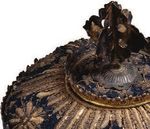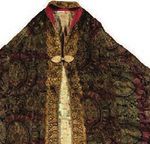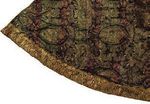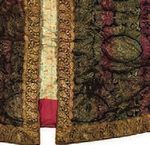Connecting Threads / Survivor Objects - August 30-December 5, 2021 - Tufts University Art ...
←
→
Page content transcription
If your browser does not render page correctly, please read the page content below
EDUCATIONAL GUIDE KEY TERMS
Connecting Threads /
Altar curtain: An ornamental curtain
hung vertically at the front of a
church, usually drawn and opened
Survivor Objects
at specific times in the liturgy and
in the liturgical year.
Batik: A traditional Javanese artistic
August 30–December 5, 2021 technique in which a wax design is
applied to a textile, after which the
textile is dyed, leaving the wax-cov-
ered portions undyed.
Block printing: An artistic technique
in which engraved wooden blocks
are covered with ink and applied to a
textile to create a repeating pattern.
Connecting Threads / Survivor Objects explores the kaleido- Cope / shurchar: A semicircular robe
scopic world of Armenian liturgical textiles from the collections worn by the priest during the liturgy.
In the Armenian tradition, the
of the Armenian Museum of America and the Museum of Fine shurchar symbolizes a shield against
Arts, Boston. Embroidered, block printed, and painted, these the attacks of the Devil.
objects dating to the eighteenth and nineteenth centuries show Diaspora: A cultural group living
outside of its traditional geographical
the multidimensional nature of liturgical textiles, reflecting the homeland.
vitality of Armenian communities during the Ottoman Empire Embroidery: An artistic technique
and their influence along global commercial routes. While many where individual threads are stitched
into a piece of fabric to produce an
Ottoman Armenian churches are now in ruins after successive ornamental design.
waves of persecution from the 1890s to the 1920s, these fragile, Genocide: Intentional violence
beautiful textiles bear witness to the survival of a people, its committed against a cultural group
with the ultimate aim of destroying
identity, and faith. that group.
The exhibition was developed with undergraduate Liturgy: Worship performed by a
and graduate students from the seminar The Threads of community of faith, usually according
to a defined, ritual pattern.
Survival: Armenian Liturgical Textiles in Local Collections at
Mitre / khoiyr: A tall headdress
Tufts University in spring 2021: Jeffrey Bui, Elettra Conoly, made of two stiff, oblong pieces of
Claudia Haines, Andrea Horn, Sara McAleer, Atineh Movsesian, material sewn together at the bottom.
Originating in the Western tradition,
Grace Rotermund, Shirley Wang, Cas Weld, and Sofia Zamboli. the khoiyr was adopted by the Arme-
Many of these textiles received the scholarly attention they nian Church during the Crusades.
deserve for the first time as students engaged in close exam- Saghavart: A tall, round headdress
worn by the priest during the liturgy,
ination of each individual textile at the Armenian Museum of
traditionally symbolizing the role of
America alongside in-class discussions about the objects Jesus Christ as King of Kings.
and relevant literature. The exhibition labels and educational Vakas: A tall, stiff piece of decorated
material present the outcome of their extensive research. linen worn around the priest’s neck,
symbolizing both obedience to Christ
and the priest’s single-minded focus
ORGANIZED BY Christina Maranci, Arthur H. Dadian and Ara Oztemel Professor
on his ministry.
of Armenian Art and Architecture, Tufts University, and Chiara Pidatella, TUAG
Research Curator. Vestment: A garment worn by a priest
during the celebration of the liturgy.
We encourage you to reach out to Liz Canter ↗, Manager of In the Armenian Church, individual
vestments are intricately decorated
Academic Programs, to discuss your plans for incorporating this and usually carry specific symbolic
exhibition into your curriculum or to arrange a class session. meanings.Major Cities This map shows major cities along with reigning empires from
Sites of Significance the 16th century to the early 20th century. It highlights
settlements of significance where the Armenian textiles were
originally produced and displayed during these four centuries
Credit: This map was created by Carolyn Talmadge, Data Lab Services
Manager, Research Technology, Tufts Technology Services. Data Sources:
Natural Earth, ESRI.Life / Afterlife KEY QUESTIONS
The liturgical textiles featured in Connecting How do the meanings of textiles develop,
Threads / Survivor Objects originated in a ritual change, and evolve across time and space?
context, survived waves of persecution from At what point does an artwork become
the 1890s to the 1920s, and are now being an artifact? What are the potential conse-
shown in a museum context. These shifts invite quences of this shift?
us to consider crucial questions about these
objects’ lives and afterlives---their variable pasts, What happens to a ritual object when it is
presents, and futures. removed from the ritual process?
Armenian
Saghavard
◀
(liturgical crown), 1751.
Metal, sequins, and gold metallic
thread on velvet.
ARMENIAN MUSEUM OF AMERICA.
RELATED RESOURCES
Interview with Christina Maranci, “Armenia in History and
the Heart ↗ ,” Radio Open Source, 2021
Christina Maranci, “Cultural Heritage in the Crosshairs
Once More ↗ ,” Wall Street Journal, 2020.
“Q&A: Armenian Genocide Dispute ↗ ,” BBC News, 2021.
Hrag Vartanian, “Artsakh: Cultural Heritage under Threat ↗ ,”
Hyperallergic, 2021.
Statement by President Joe Biden on Armenian Remem-
brance Day ↗ , the White House, 2021.
Armenian Genocide ↗ , Khan Academy.Network / Movement KEY QUESTIONS
Under the Ottoman Empire, Armenian communi- How are these textiles representative
ties occupied a broad geographical area ranging of global social, religious, economic, and
from the Caucasus to the Anatolian peninsula, intellectual networks? How do they
from Crimea to Russia and Western Europe, and demonstrate the fusion of traditions and
from Amsterdam to East and South Asia. The visual styles across time and space?
textiles in this exhibition originated in the pros- How did movement play a role in the
perous Armenian communities of Istanbul, Tokat, creation, lives, and afterlives of these
Talas, Kutahya, and Gumushane—all
, in modern objects?
-day Turkey—as well as in Armenian trading
settlements in Surabaya, Indonesia. Examining Could textiles be considered commodities?
the social, religious, economic, and intellectual Why or why not?
networks within which these textiles have
traveled allows us to shed light on their functions,
Shurchar, (cope or priest’s robe),
◀
meanings, and values in both the past and the possibly late 19th century, as late
present. as 1933.
Silk, metallic thread, machine lace trim,
metal clasps; lining: printed cotton and silk.
ARMENIAN MUSEUM OF AMERICA
RELATED RESOURCES
Armenian Diaspora Communities ↗ , Office of the High Com- The Armenian Diaspora ↗ , Library of Congress Country
missioner for Diaspora Affairs. Studies.
Helen Evans: Armenian Art and Creative Exchange on Me- Sebouh Aslanian—On the Boundaries of History The
dieval Trade Routes ↗ , Armenian General Benevolent Union, Armenian Diaspora of the Early Modern Period ↗ , Armenian
YouTube, 2018. General Benevolent Union, YouTube, 2020.Communities / Individuals KEY QUESTIONS
Because these liturgical textiles were created What relationship did these objects have
for use in a religious context, they held special with their makers, users, and communities?
and highly personal meanings for their original Who wore or displayed these textiles?
makers, users, and communities. In this way, Who viewed them in their original context?
they act as powerful embodiments both How are these past audiences similar to or
of pride in Armenian Orthodox traditions and different from the audiences of Connecting
of Armenian identity more broadly. Threads / Survivor Objects?
How do religious garments, textiles, and
other ritual objects contribute to and reflect
a given religious tradition’s unique cultural
legacy?
Vakas (amice or collar), 1751.
◀
Silk canvas embroidered with metallic silver, gold, yellow,
and brown threads leather backing and stiff paper support.
ARMENIAN MUSEUM OF AMERICA.
RELATED RESOURCES
Vestments ↗ , the Western Diocese of the Armenian Apostolic
Church of North America, YouTube, 2019.
The Divine Liturgy of the Armenian Church ↗ , the Eastern
Diocese of the Armenian Apostolic Church of North America,
YouTube, 2011.
Object Show and Tell: Liturgical Vestments ↗ , the Armenian
Museum of America, YouTube, 2021.Materials / Techniques
The textiles featured in Connecting Threads /
Survivor Objects reflect a wide variety of ma-
terials and techniques, including embroidery,
block printing, dye, painting, and much more.
Closely examining the materiality of these
objects invites us to consider who made them
and what types of artistic processes they used,
and to appreciate the time, care, and expense
invested into their production.
KEY QUESTIONS
Who is involved in the production of textiles?
How does the process of producing a textile
add to its value?
How do the unique materials and techniques
involved in textile production differ from
those of other artistic media and processes?
Can we identify evidence of movement,
trade, and exchange through the materials
used in these textiles?
Armenian, Embroidery
The Crucifixion, late eighteenth
◀
or early nineteenth century.
Cotton and silk, embroidery.
MUSEUM OF FINE ARTS, BOSTON.
RELATED RESOURCES
Arts of Armenia—Textiles ↗ , Armenian Studies Program at
Fresno State University.
A Sampling of Armenian Embroideries from the Collection
of the Armenian Museum of America ↗ , Armenian Museum of
America.
Batik of Java: A Centuries-Old Tradition ↗ , Asian Art Museum,
YouTube, 2017.
Object Show and Tell: Altar Curtain ↗ , the Armenian Museum
of America, YouTube, 2021You can also read



























































